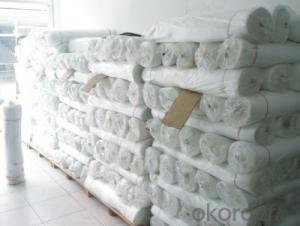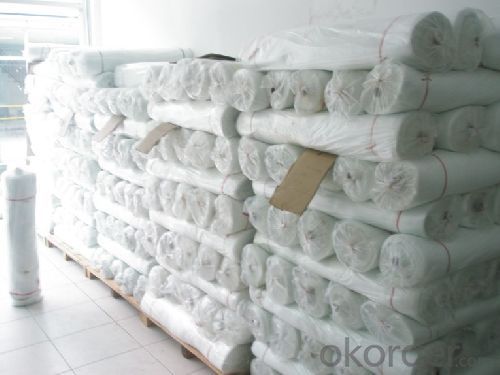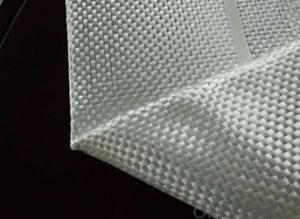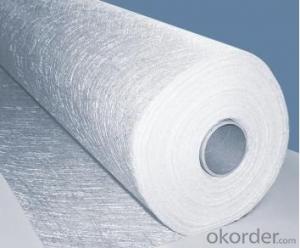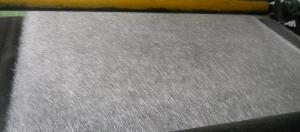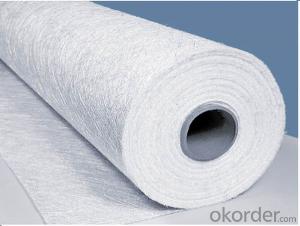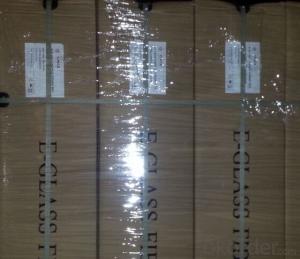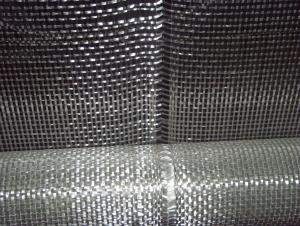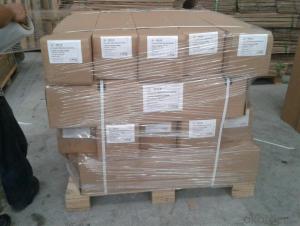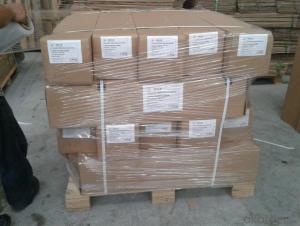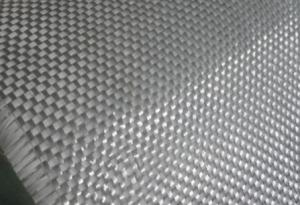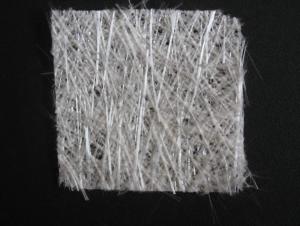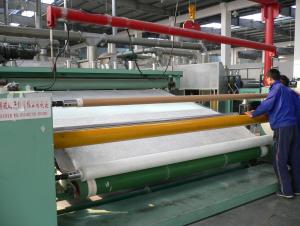Fiberglass Mat Tissue E-Glass Woven Roving Fabric
- Loading Port:
- Shanghai
- Payment Terms:
- TT or LC
- Min Order Qty:
- 16000 kg
- Supply Capability:
- 200000Kg Per Month kg/month
OKorder Service Pledge
OKorder Financial Service
You Might Also Like
1.Brief Introductions
E-Glass Woven Rovings are bidirectional fabric made by interweaving direct rovings.
E-Glass Woven Rovings are compatible with unsaturated polyester, vinyl ester, epoxy and phenolic resins.
E-Glass Woven Rovings are a high-performance reinforcement widely used in hand lay up and robot processes to manufacture boats, vessels, plane and automotive parts, furniture and sports facilities.
2.Product Features
Warp and weft rovings aligned in a parallel and flat manner, resulting in uniform tension
Densely aligned fibers, resulting in high dimensional stability and making handling easy
Good moldability, fast and complete wet out in resins, resulting in high productivity
Good mechanical properties and high strength of parts
3.Product Specifications
Property | Area Weight | Moisture Content | Size Content | Width |
(%) | (%) | (%) | (mm) | |
Test Method | IS03374 | ISO3344 | ISO1887 | |
EWR200 | ±7.5 | ≤0.15 | 0.4-0.8 | 20-3000 |
EWR270 | ||||
EWR300 | ||||
EWR360 | ||||
EWR400 | ||||
EWR500 | ||||
EWR600 | ||||
EWR800 |
Special specification can be produce according to customer requirements.

4.FAQ
Packaging:
Each woven roving is wound onto a paper tube which has an inside diameter of 76mm and the mat roll has a diameter of 220mm. The woven roving roll is wrapped up with plastic film,and then packed in a cardboard box or wrapped up with kraft paper. The rolls can be horizontally placed. For transportation, the rolls can be loaded into a cantainer directly or on pallets.
Unless otherwise specified,It should be stored in a dry, cool and rain-proof area. It is recommended that the room temperature and humidity should be always maintained at 15℃~35℃ and 35%~65% respectively.
- Q: What is the thickness range of fiberglass mat tissue?
- The thickness of fiberglass mat tissue may vary depending on the product and manufacturer at hand. Generally, one can find fiberglass mat tissues in thicknesses that span from 0.1mm to 1mm. It is worth emphasizing that the thickness of the fiberglass mat tissue plays a significant role in determining its strength, flexibility, and various other qualities. Therefore, it is imperative to carefully choose the suitable thickness that aligns with the intended application.
- Q: Can fiberglass mat tissue be used for corrosion-resistant coatings?
- Corrosion-resistant coatings can utilize fiberglass mat tissue, a non-woven fabric composed of fine fiberglass strands bonded together using a binder. Due to its exceptional strength and corrosion resistance qualities, fiberglass mat tissue is commonly employed as a reinforcement material in composite applications. When integrated into corrosion-resistant coatings, fiberglass mat tissue acts as a protective barrier against the corrosive surroundings, safeguarding the underlying surface from deterioration caused by chemicals, moisture, and other corrosive substances. Moreover, fiberglass mat tissue can be impregnated with diverse resin systems that enhance its capacity to resist corrosion. These resin systems offer supplementary safeguard against specific corrosive agents or environments, consequently heightening the effectiveness of the coating. Furthermore, the flexibility and moldability of fiberglass mat tissue enable it to conform effortlessly to intricate shapes and surfaces, guaranteeing comprehensive coverage and protection against corrosion. In conclusion, fiberglass mat tissue is a dependable and efficient material for corrosion-resistant coatings. Its impressive strength, corrosion resistance, and compatibility with various resin systems make it a suitable choice for shielding surfaces in corrosive environments.
- Q: Can fiberglass mat tissue be used for making lightweight ceilings?
- Yes, fiberglass mat tissue can be used for making lightweight ceilings. Fiberglass mat tissue is a thin and lightweight material made from fiberglass strands that are bonded together with a binder. It is commonly used in construction and building applications due to its excellent strength-to-weight ratio. When used for making lightweight ceilings, fiberglass mat tissue can provide several advantages. Firstly, it is lightweight, which makes it easier to handle and install. This can save time and effort during construction or renovation projects. Additionally, fiberglass mat tissue is also known for its high tensile strength and durability, making it a suitable choice for ceilings that need to withstand various loads and stresses. Furthermore, fiberglass mat tissue has good thermal insulation properties, which can help in maintaining a comfortable indoor environment. It can also offer sound insulation benefits, reducing noise transmission between different spaces or floors. Moreover, fiberglass mat tissue is resistant to moisture, mold, and mildew, which makes it suitable for areas with high humidity or moisture concerns such as bathrooms or kitchens. It is also non-combustible, providing an added level of fire resistance to the ceiling structure. In conclusion, fiberglass mat tissue can indeed be used for making lightweight ceilings. Its lightweight nature, strength, durability, thermal and sound insulation properties, as well as resistance to moisture and fire, make it a suitable choice for various ceiling applications.
- Q: Is fiberglass mat tissue resistant to UV degradation?
- Yes, fiberglass mat tissue is generally resistant to UV degradation. The material is designed to withstand exposure to sunlight and does not easily degrade or deteriorate due to UV radiation.
- Q: Can fiberglass mat tissue be used for marine applications?
- Yes, fiberglass mat tissue can be used for marine applications. It is commonly used in boat building and repair due to its excellent strength, durability, and resistance to water and corrosion. The fiberglass mat tissue helps reinforce the structure of marine vessels and provides added protection against the harsh marine environment.
- Q: Can fiberglass mat tissue be used for wind turbine blades?
- Indeed, wind turbine blades can utilize fiberglass mat tissue. This material, known for its lightness and durability, finds widespread use in constructing wind turbine blades. It boasts an impressive strength-to-weight ratio and possesses resistance against corrosion, making it an optimal choice for enduring the harsh environmental circumstances faced by wind turbine blades. Moreover, fiberglass mat tissue can effortlessly be shaped into intricate forms, enabling the production of aerodynamically efficient wind turbine blades. All in all, integrating fiberglass mat tissue into wind turbine blades enhances their performance and longevity.
- Q: Can fiberglass mat tissue be used for decorative applications?
- Yes, fiberglass mat tissue can be used for decorative applications. Fiberglass mat tissue is a thin, lightweight material that is commonly used in the construction industry for reinforcing various products such as composites, plastics, and resins. However, it can also be utilized for decorative purposes. The smooth and glossy surface of fiberglass mat tissue makes it an ideal choice for adding a decorative finish to surfaces. It can be used to create unique textures, patterns, or designs on surfaces such as walls, ceilings, furniture, and even art installations. Its versatility allows it to be easily shaped, molded, or formed into different shapes, making it suitable for various creative applications. Moreover, fiberglass mat tissue is available in different colors, allowing for further customization and enhancing its decorative potential. It can be painted or coated with various finishes to achieve the desired aesthetic effect. Additionally, it is a durable material that is resistant to moisture, chemicals, and UV radiation, making it suitable for both indoor and outdoor decorative applications. Overall, fiberglass mat tissue can be an excellent choice for adding a decorative touch to various surfaces due to its smooth surface, versatility, and durability. Whether it is used for architectural design, interior decoration, or artistic installations, it offers a wide range of possibilities for creating visually appealing and unique decorative applications.
- Q: How is fiberglass mat tissue bonded to surfaces?
- Adhesive materials are commonly utilized to bond fiberglass mat tissue to surfaces. To initiate the bonding process, the adhesive is applied onto the surface where the fiberglass mat tissue will be attached. Typically, a two-part epoxy resin or a specialized fiberglass adhesive, specifically formulated for bonding fiberglass materials, is used. Following the manufacturer's instructions, the adhesive is thoroughly mixed and then evenly spread onto the surface using a brush, roller, or trowel. With utmost care, the fiberglass mat tissue is then placed onto the adhesive-covered surface and firmly pressed down to ensure optimal adhesion. Subsequently, the adhesive is left to cure for the recommended duration, allowing it to solidify and establish a robust bond between the fiberglass mat tissue and the surface. This bonding technique guarantees the secure attachment of the fiberglass mat tissue to the surface, offering reinforcement, protection, or other desired attributes based on the specific application.
- Q: Can fiberglass mat tissue be used for making insulation boards?
- Yes, fiberglass mat tissue can be used for making insulation boards. The tissue provides strength, stability, and reinforcement to the insulation material, making it an effective choice for insulation board manufacturing.
- Q: Can fiberglass mat tissue be used for automotive applications?
- Yes, fiberglass mat tissue can be used for automotive applications. It is commonly used in the automotive industry for reinforcement and strength in parts such as body panels, hoods, and interior components. It provides excellent thermal and acoustic insulation properties as well.
Send your message to us
Fiberglass Mat Tissue E-Glass Woven Roving Fabric
- Loading Port:
- Shanghai
- Payment Terms:
- TT or LC
- Min Order Qty:
- 16000 kg
- Supply Capability:
- 200000Kg Per Month kg/month
OKorder Service Pledge
OKorder Financial Service
Similar products
Hot products
Hot Searches
Related keywords
